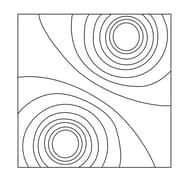Two conducting spheres are separated by a distance that is large compared with their radii. The first sphere has a radius of and has a charge of on its surface. The second sphere has a radius of and is neutral. The spheres are then connected by a long conducting wire.
Find the charges on each sphere.

Important Questions on Fields (HL)
Two conducting spheres are separated by a distance that is large compared with their radii. The first sphere has a radius of and has a charge of on its surface. The second sphere has a radius of and is neutral. The spheres are then connected by a long conducting wire.
Calculate the charge density on each sphere (charge density is the total charge on the sphere divided by the surface area of the sphere).
Two conducting spheres are separated by a distance that is large compared with their radii. The first sphere has a radius of and has a charge of on its surface. The second sphere has a radius of and is neutral. The spheres are then connected by a long conducting wire.
Calculate the electric field on the surface of each sphere. (use .)
Two conducting spheres are separated by a distance that is large compared with their radii. The first sphere has a radius of and has a charge of on its surface. The second sphere has a radius of and is neutral. The spheres are then connected by a long conducting wire.
Comment on your result in the light of your answer to part that is calculation of charge density. Why it is stated that wire is long
The diagram shows the equipotential lines for two equal and opposite charges. Draw the electric field lines for these two charges.

The two long plates are separated by a distance of . The bottom plate is kept at a potential of and the top at . A charge is placed at a point from the bottom plate.
Find the electric potential energy of the charge.
The two long plates are separated by a distance of . The bottom plate is kept at a potential of and the top at . A charge is placed at a point from the bottom plate.
The charge is then moved vertically up to a point from the top plate.
What is the electric potential energy of the charge now
The two long plates are separated by a distance of . The bottom plate is kept at a potential of and the top at . A charge is placed at a point from the bottom plate.
The charge is then moved vertically up to a point from the top plate.
How much work was done on the charge
An electron is shot with a speed equal to from a point where the electric potential is zero towards an immovable negative charge (see the diagram).

Determine the potential at so that the electron stops momentarily at and turns back. (Use
